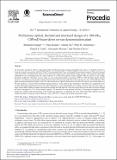| dc.contributor.author | Grange, Benjamin | |
| dc.contributor.author | Kumar, Vikas | |
| dc.contributor.author | Armstrong, Peter R. | |
| dc.contributor.author | Codd, Daniel S. | |
| dc.contributor.author | Calvet, Nicolas | |
| dc.contributor.author | Gil Pujol, Antoni | |
| dc.contributor.author | Slocum, Alexander H | |
| dc.date.accessioned | 2019-01-24T14:52:56Z | |
| dc.date.available | 2019-01-24T14:52:56Z | |
| dc.date.issued | 2015-08 | |
| dc.identifier.issn | 1876-6102 | |
| dc.identifier.uri | http://hdl.handle.net/1721.1/120121 | |
| dc.description.abstract | An innovative concept in which a single-tank molten salt thermal energy storage arrangement also acts as a volumetric receiver is being developed in connection with the CSPonD[superscript 2] (Concentrated Solar Power on Demand Demonstration) project. The tank is located at the focal point of a beam-down tower to act as both solar energy receiver and thermal energy storage. The relatively small angle subtended by rays emanating from the central reflector of a beam down optical system, together with the nature of solar energy absorption within the volumetric receiver, make use of a compound parabolic concentrator (CPC) or CPC-like final optical element attractive. An effective concentration of about 4 can be achieved to increase solar flux at the tank aperture from 150 to 600 suns. This paper describes preliminary designs of the CPC and tank/receiver. Optical simulations reveal that, for a given solar incident power at the tank aperture, a conical final concentrator design produces a more uniform flux distribution with better axial alignment (lower average horizontal component) of rays at its outlet compared to a conventional CPC of revolution. However the cone may require a
larger outlet radius, leading to higher thermal losses through the tank aperture. With the current design of the tank, the losses through the walls correspond to 5.5 % of the thermal capacity. To maximize the tank thermal efficiency, a thorough investigation will be carried out, starting with measurements of the molten salt emissivity, to determine the cone outlet radius/tank aperture and cone height that achieve maximum system efficiency with a 250-550 °C molten salt working temperature range. Keywords: Thermal energy storage; Concentrated solar power; Molten salt; Thermocline; Beam-down tower; CPC, Cone, Ray-tracing. | en_US |
| dc.description.sponsorship | Abu Dhabi (United Arab Emirates) | en_US |
| dc.description.sponsorship | MIT & Masdar Institute Cooperative Program | en_US |
| dc.publisher | Elsevier BV | en_US |
| dc.relation.isversionof | http://dx.doi.org/10.1016/J.EGYPRO.2015.07.359 | en_US |
| dc.rights | Creative Commons Attribution-NonCommercial-NoDerivs License | en_US |
| dc.rights.uri | http://creativecommons.org/licenses/by-nc-nd/4.0/ | en_US |
| dc.source | Elsevier | en_US |
| dc.title | Preliminary Optical, Thermal and Structural Design of a 100 kWth CSPonD Beam-down On-sun Demonstration Plant | en_US |
| dc.type | Article | en_US |
| dc.identifier.citation | Grange, Benjamin, Vikas Kumar, Antoni Gil, Peter R. Armstrong, Daniel S. Codd, Alexander Slocum, and Nicolas Calvet. “Preliminary Optical, Thermal and Structural Design of a 100 kWth CSPonD Beam-down On-Sun Demonstration Plant.” Energy Procedia 75 (August 2015): 2163–2168. © 2015 The Authors | en_US |
| dc.contributor.department | Massachusetts Institute of Technology. Department of Mechanical Engineering | en_US |
| dc.contributor.mitauthor | Gil Pujol, Antoni | |
| dc.contributor.mitauthor | Slocum, Alexander H | |
| dc.relation.journal | Energy Procedia | en_US |
| dc.eprint.version | Final published version | en_US |
| dc.type.uri | http://purl.org/eprint/type/JournalArticle | en_US |
| eprint.status | http://purl.org/eprint/status/PeerReviewed | en_US |
| dc.date.updated | 2019-01-02T18:22:00Z | |
| dspace.orderedauthors | Grange, Benjamin; Kumar, Vikas; Gil, Antoni; Armstrong, Peter R.; Codd, Daniel S.; Slocum, Alexander; Calvet, Nicolas | en_US |
| dspace.embargo.terms | N | en_US |
| dc.identifier.orcid | https://orcid.org/0000-0002-4900-1317 | |
| dc.identifier.orcid | https://orcid.org/0000-0002-5048-4109 | |
| mit.license | PUBLISHER_CC | en_US |
